Propagation of Native Species
Table of Contents
Refer to Appendix A Table 1A [to be added soon] for establishment recommendations for individual species.
Propagation of native species through agronomic methods is necessary to scale up seed supplies for restoring native vegetation in highly fragmented landscapes such as the Midwestern Corn Belt of the US. However, information and techniques for propagating the diverse species needed for restoration are often in short supply, or are closely held secrets of private native seed producers. Here we present methods gleaned from a variety of sources, many of which we have used at the Tallgrass Prairie Center in production of source-identified stock seed for regional native seed growers.
This chapter focuses on establishment of production plots using transplants grown in a greenhouse. This approach has advantages: making efficient use of small amounts of stock seed and achieving more reliable seedling establishment (hence, efficient use of prepared plot space). However, it requires specialized facilities and involves considerable labor. Direct seeding is an effective method for establishing some native prairie species, notably the dominant grasses. Preparing a clean, weed-free seed bed and ensuring that seed is planted at the right depth (i.e., not buried too deeply) are crucial. In the species production guides, we provide estimates of the amount of seed needed, row spacing, and planting depth for direct seeding. However, we do not have experience with direct seeding all of the species and include a disclaimer to that effect when applicable.
Most of the species produced at the TPC have been grown in single-species plots of up to ½ acre or in 4-ft wide rows up to 150-ft long. Some growers produce seed using native or introduced grasses as cover crops within forb rows, in mixed cropping systems of a few species, or by reconstructing prairies for the purpose of seed harvest.
Wild species grown for seed production may show signs of adaptation to production conditions over several generations. At each step in propagation, there is potential for selection for genetic traits that improve fitness in an agronomic production system but may alter the ability of the seed to produce plants capable of establishing, surviving, and reproducing in the wild. Within each of the following sections, we will point out the risk of unintended selection and strategies for avoiding it. These strategies are also summarized in the Chapter: Seed Source and Quality. They will sometimes be in tension with the need for private seed companies to produce a profitable crop.
- Seed Dormancy
Dormancy describes seed that does not germinate even when presented with favorable conditions of moisture, temperature, and light. Dormancy is an adaptive trait, allowing germination to occur over time and in the proper season. This vital trait prevents the germination of all seeds at a time that might be suboptimal, or even lethal, for seedling establishment. Staggered germination over time is normal, even with stratification, and should be expected when propagating native prairie species.
The benefits of removing dormancy are twofold: First, more seeds germinate in a shorter period of time, which means limited and costly greenhouse space is used more efficiently. Second, increased germination means that more individual plants will potentially establish, flower, and reproduce, contributing their genetic diversity to the next generation.
There are two main categories of dormancy – primary and secondary. Primary dormancy occurs when seed is dormant upon dispersal, which is typical of many prairie species. Species with secondary dormancy produce seed with the ability to germinate readily upon dispersal (fresh); however, the seed may enter a dormant state if conditions aren’t favorable. Many woodland spring ephemeral species belong to this category of dormancy.
Within the two primary categories, there are several types of seed dormancy, and appropriate strategies are required to remove each type (Table 1). The most common type of dormancy in prairie plants of the grass and sunflower families is physiological dormancy, resulting from biochemical compounds that inhibit germination. The compounds may be produced in the seed itself or translocated to the seed from the plant prior to dispersal. Abscisic acid (ABA), for example, prevents premature germination of mature seeds in the seed head, before dispersal from the parent plant. Concentrations of germination inhibitors, like ABA, decline over time, allowing the seed to germinate. Physiological dormancy may respond to chemical treatments such as gibberellic acid or ethylene which counteract ABA. Another type, physical dormancy, is due to a physical characteristic of the seed; for example, the seed coat may be hard or waxy or otherwise impermeable to water and gas exchange, thus inhibiting germination. Species in the sumac, legume, geranium, and buckthorn families have these characteristics. Seeds with physical dormancy require scarification to remove these barriers. A third type is morphological dormancy: the embryo within the seed is underdeveloped upon dispersal, and warm, moist conditions are generally necessary for maturation (55 to 65 °F, 13 to 18 °C). Species with this type of dormancy are found in the parsley, buttercup, arum, lily, and iris families, among others (Baskin and Baskin 1998). Many seeds may have a combination of morphological and physiological dormancy types, i.e., morphophysiological dormancy, a subtype of which is sometimes referred to as double dormancy. Seeds of these species are often slow to germinate and may require lengthy stratification or repeated stratification at different temperatures. Examples of morphophysiological dormancy are found in the lily, gentian, buttercup, and parsley families. Combinational dormancy means that seeds have both a physical barrier to germination and biochemical inhibitors. Such seeds need both scarification and stratification in order to germinate. Some legumes and members of the borage and buckthorn families fit in this category.
Table 1. Types of dormancy associated with family groups and strategies for breaking dormancy (Adapted from Baskin and Baskin 1998).
Type of Dormancy
Cause
Removed by
Physiological
Biochemical inhibitors of germination (i.e., abscisic acid)
Cold and/or warm stratification, treatment with gibberellic acid (GA) or ethylene, light or dark conditions
Most common form of dormancy in the grass and sunflower families
Physical
Seed coat impermeable to water/gases
Scarification to simulate natural breakdown of barriers to water uptake
Found in legume, sumac, geranium, and buckthorn families
Morphological
Underdeveloped embryo
Conditions for embryo development, usually warm, moist conditions
Found in parsley, buttercup, arum, and lily families
Morphophysiological
Underdeveloped embryo and biochemical inhibitors
Lengthy stratification or a sequence of stratification periods at different temps; some species respond to GA
Found in gentian, buttercup, parsley, and lily families
Combinational
Physical barriers and biochemical inhibitors
Scarification (including wet heat) and stratification
Found in borage, buckthorn, and some members of legume family
Choosing Dormancy Breaking Treatments
When planning to propagate native species for seed production, it is important to consider the likelihood of seed dormancy and choose methods to effectively reduce it in that species. Within a plant species and population, individuals vary in their degree of dormancy due to complex genetic traits. If dormancy is not broken, individuals carrying this trait will be eliminated from the production population.
Several sources for finding dormancy breaking information are listed in the references for this chapter, including scientific publications, native plant nursery websites, and a searchable plant propagation database. Information in these sources comes from either scientific studies of germination or practical experience, or both. When different sources disagree significantly, it may be advantageous to divide the seed and subject different samples to each of the suggested treatments. It is also wise to consider the geographic source of the information, as levels of dormancy may differ within a species along a north-south gradient of its natural range (or altitude in other regions). Use caution in applying suggestions from native plant nursery websites: dormancy is a genetic trait that can be diminished in a production population over a few generations unless the grower has applied dormancy-breaking strategies.
For some species, little to no information is available. In those cases, first consider the natural timing of seed dispersal for the species. If its seed typically disperses in fall, cold stratification of different lengths is a good starting point. You may also find protocols for closely related species, divide the seed, and try a range of treatments based on what has worked for other members of the genus. Baskin and Baskin have published a more empirical method called the ‘move-along experiment’ that helps to determine the set of temperature treatments needed to germinate one of these unknowns. If you manage to ‘crack the code’ on a difficult species, consider sharing your techniques on the RNGR Propagation Protocols Database.
- Seed Treatments
Scarification
Scarification is a technique that simulates the natural disintegration of the seed coat to initiate germination. A hard or waxy coat will not allow the seed to soak up (imbibe) the water needed for germination until the seed coat breaks down. Seed is scarified either through natural processes such as weathering, abrasion, or partial digestion, or through artificial techniques. Seeds have natural openings for water uptake and these weather or wear away first, especially in seeds with hard seed coats, allowing the seed to imbibe water so germination can occur. The trick of scarification, then, is to accelerate the process of weathering these natural openings so seeds can imbibe water, but stopping short of damaging the seed. Some simple scarification techniques are presented here.
Sandpaper wood blocks – These blocks can be constructed using rubber cement to glue a sheet of fine-grain sandpaper to each of two flat plywood boards. Lay one sand block on a tray and use light pressure and a circular motion to move the other sand block on top of a quantity of seed sandwiched in between the two blocks. Adequate scarification is achieved after a minute or two, when seed begins to look dull.
Percussion scarification – Seeds are shaken vigorously inside a heavy glass bottle for a few minutes. Allow ample room for all of the seeds to impact the sides of the bottle. This technique is considered less aggressive and less likely to damage seeds than the sand block method. In a variation of percussion scarification, a pneumatic paint shaker was modified by Khadduri and Harrington (2002) to scarify the very hard seeds of native locust tree species (Robinia neomexicana, R. pseudoacacia).
Wet heat – Pour boiling water (212°F, 100°C) over the seeds just enough to cover them and allow to cool to room temperature, or immerse seeds in boiling water for five to twenty seconds and remove to rinse and cool. This technique is reserved for certain species and is not broadly recommended. Some species will also require stratification after wet heat. This is effective for New Jersey tea (Ceanothus americanus), hairy puccoon (Lithospermum caroliniense, followed by 90-day cold stratification), and reportedly for false gromwell (Onosmodium molle).
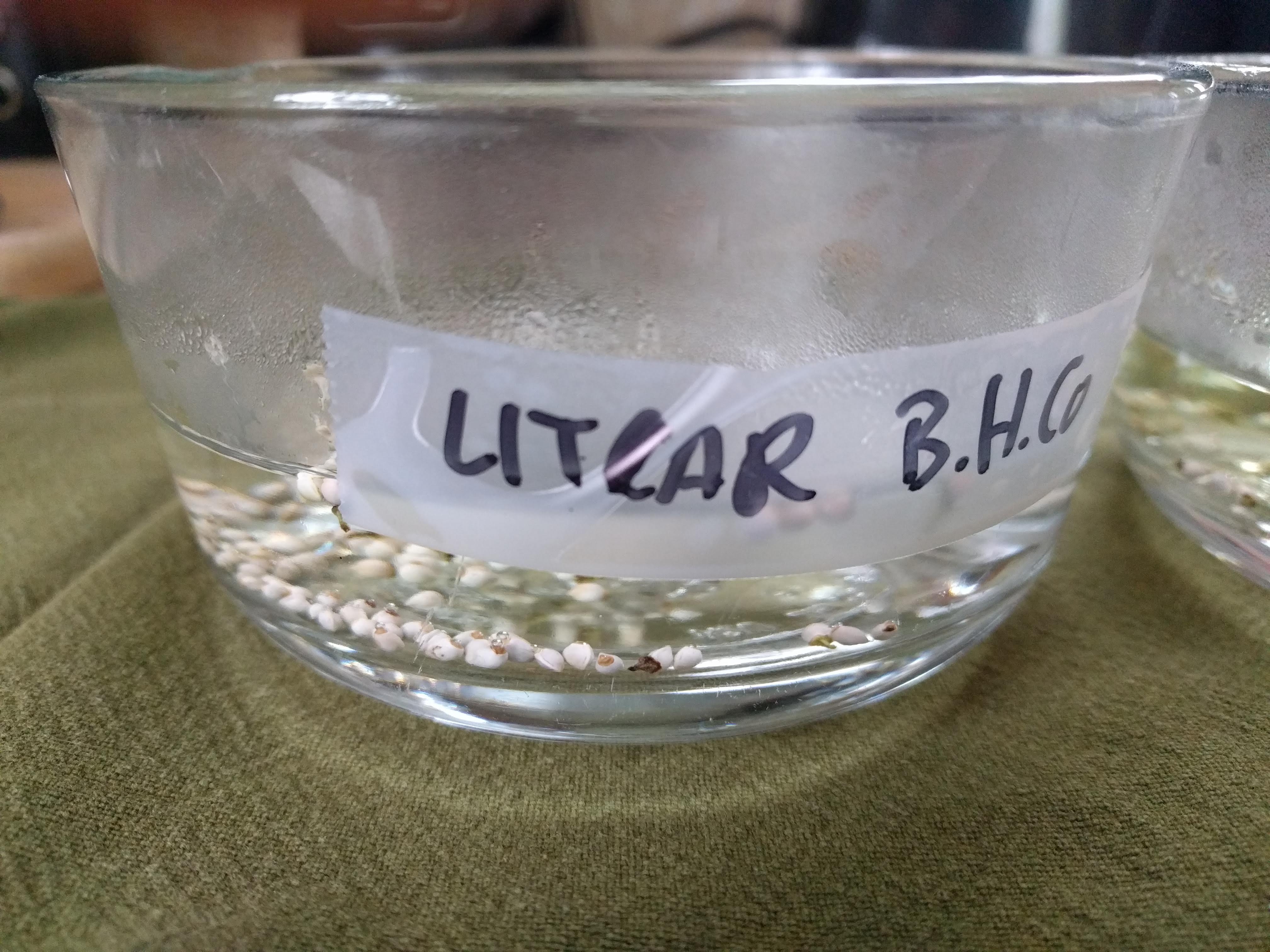
Image: Hairy puccoon, Lithospermum caroliniense, nutlets subjected to boiling water scarification prior to being cold/moist stratified for 90 days. Commercial scarifiers are also available from seed equipment manufacturers, such as a Forsberg scarifier, a sandpaper-lined cylinder with metal paddles that turn and agitate the seed. This is a very aggressive method and only a few seconds are generally needed. Precious seed can be reduced to flour if left on too long. Seed may already have been scarified as part of the cleaning process (e.g., if a scarifier/brush machine was used for dehulling legume seeds). Contact your seed vendor/producer to determine if the seed has been cleaned with a scarifier/brush type machine.
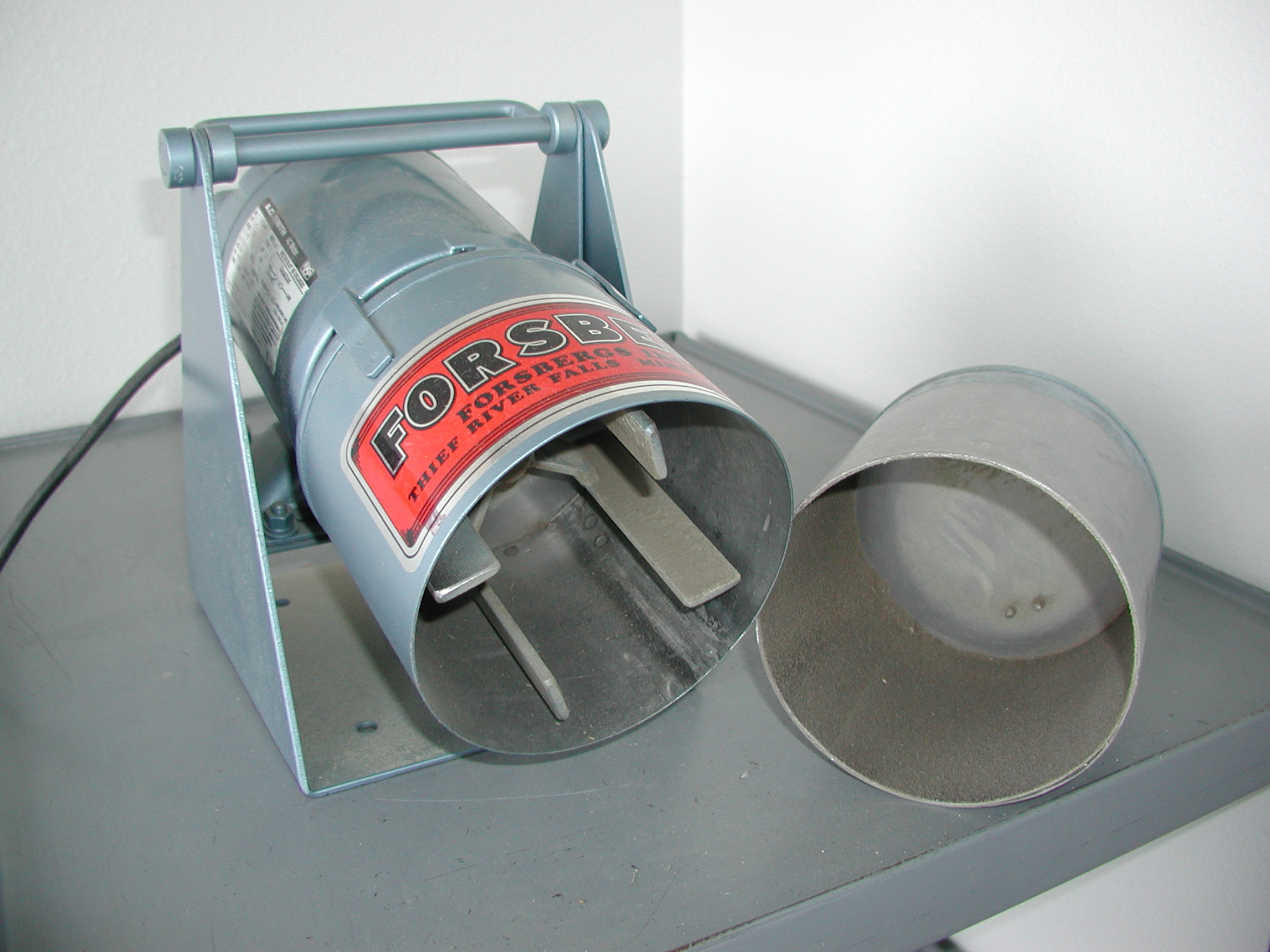
Image: A Forsberg scarifier, to be used with caution. Stratification
Stratification is a process whereby seeds are placed in a moist medium such as clean sand or vermiculite at appropriate temperatures for a specified period of time. The idea is to mimic critical conditions necessary for germination that seeds are exposed to naturally in the environment after dispersal. Generally, if seeds are dispersed in autumn, they may require cold, moist stratification. If dispersed in late spring or early summer, they may require warm, moist conditions, or warm followed by cold stratification, as in Michigan lily (Lilium michiganense). Mix seed with an equal amount of moist, sterile sand, sawdust, peat, or vermiculite and place in a zip-closure bag or small plastic container. Avoid excessive moisture; water should not be pooled anywhere in the bag or container. Use vermiculite if working with species adapted to drier conditions to minimize the risk of rot. If it is desirable to separate the seed from the medium after stratification, one strategy is to place the seed in a small fine-mesh (organza) bag such as those used for wedding favors, then sandwich the bag between layers of moist stratification media.
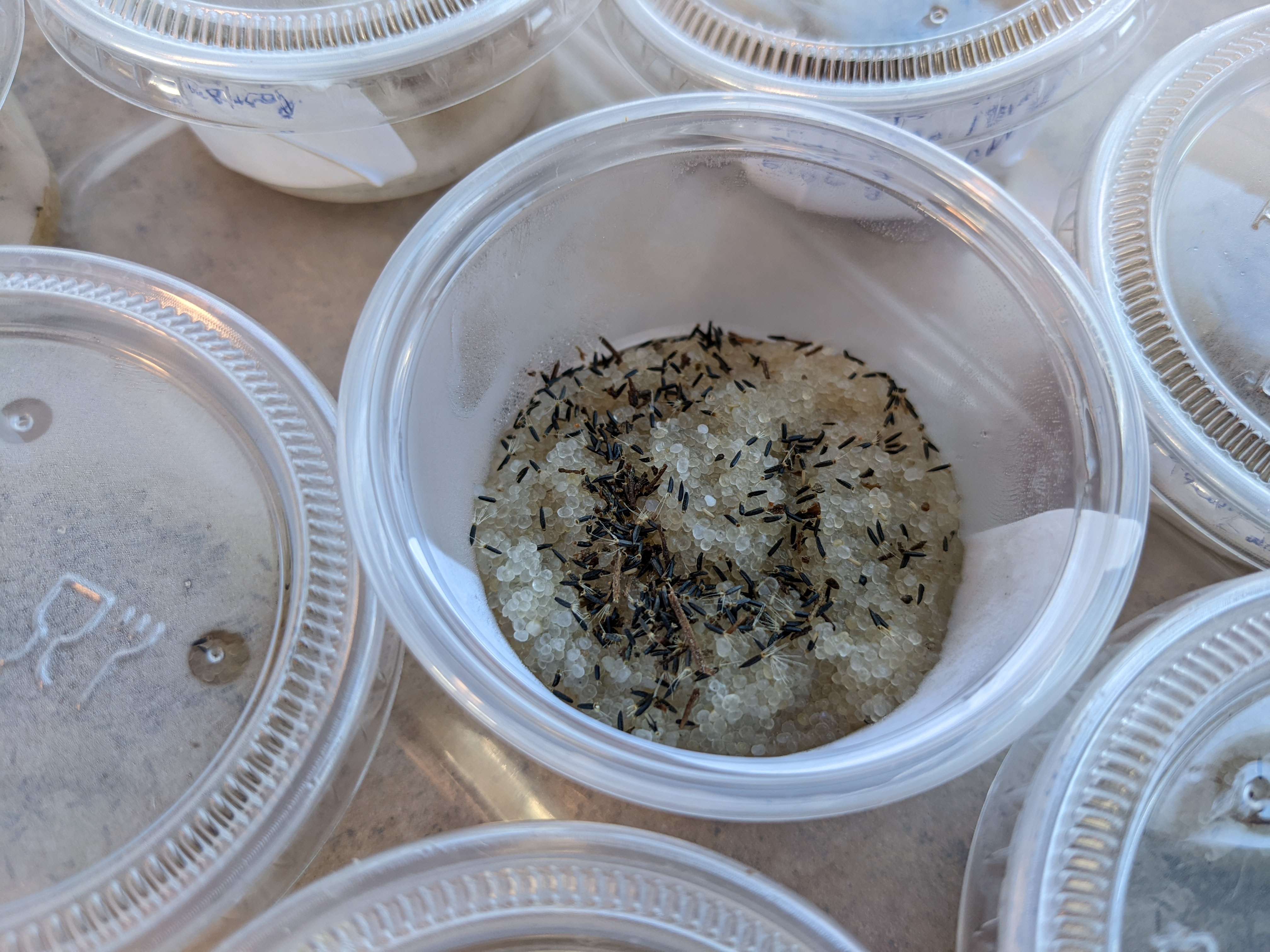
Image: Seeds of common boneset (Eupatorium perfoliatum) in containers of moist silica sand placed at 40°F for 60 day stratification. Effective temperatures for cold stratification are from 32 to 45 °F (0 to 10 °C), with 41 °F (5 °C) considered optimal for many species (Baskin and Baskin 1998). Some species require as little as ten days, others as long as 120 days. A few species, among them American vetch (Vicia americana) and butterfly milkweed (Asclepias tuberosa), will germinate at these temperatures, so check bags weekly to look for emergence of the radicle and plant immediately if this occurs. Some species may germinate best when stratified under natural winter temperature fluctuations (for example, in an unheated building). If sowing seeds in flats for outdoor stratification, cover with screen mesh to protect seeds from being displaced by animals or heavy rains. Cold frames can be used for stratification and extending the growing season in the spring. Effective temperatures for warm stratification are from 68 to 94°F (20 to 35°C), with 68 to 76°F (20 to 24°C) optimal for many species with this requirement (Baskin and Baskin 1998).
Rhizobium Inoculation
Rhizobium are types of nitrogen-fixing bacteria that live symbiotically with the roots of many species, typically forming nodules on rootlets of the plant. They “fix” nitrogen by converting gaseous nitrogen from the air spaces in the soil into plant-available ammonia nitrogen, which directly benefits the host plant. The plant, in turn, provides carbohydrates for the rhizobium. Strains of rhizobium have been isolated and are commercially available for groups of species, notably the genera Amorpha, Lespedeza, and Dalea. Rhizobium comes as a black powder that is mixed with the seed just prior to planting. Greenhouse-grown seedlings of legumes benefit from rhizobium inoculation. It may be unnecessary to inoculate with rhizobium, however, if seedlings will be planted within a few weeks after germination into native soil where rhizobium naturally occurs.
Mycorrhizal Inoculation
Mycorrhiza means “fungus root” and describes a symbiotic relationship between plants and fungi. This is common in many, if not most, plant species. Mycorrhizal fungi are naturally occurring in healthy soil, but may need to be provided for soils that have been fallow, flooded, or eroded over long periods. Sites disturbed by extensive and long-term construction grading or altered by mining will also benefit from inoculation. Commercial inoculum consisting of endomycorrhizal spores, host plant roots, and a sterilized medium is now available, and this can be incorporated into the soil at the time of seeding or transplanting. Inoculation of the site with healthy soil from a different location is another option.
- Greenhouse Propagation
Once viable seed is obtained and pre-treated to remove dormancy, it is ready to plant in the greenhouse. Critical factors include a suitable container and potting medium, water, soil temperature, light, and air.
Containers
Containers should provide good drainage and space for root development and yet be small enough to provide efficient use of potting medium and bench space. Nurseries interested in retail seedling/plant production will first germinate seeds in flats, which take up much less greenhouse space. Seedlings are then transplanted into disposable trays with perforated pull-apart planting cells for retail marketing.
Seedlings for transplant into seed production rows can be grown in plug trays or a modular reusable “cone-tainer” and tray system. In recent years, the TPC has had success with 2.5” deep, 73-cell plug flats that are ridged to direct root development downward and have ¾” bottom openings to encourage root pruning and the formation of firmly rooted plugs for transplanting. It is easier to maintain even watering with these plugs than deeper cone-tainers, and a transplantable plug can be produced in a shorter time for most species. In addition, the shallower depth of holes required for transplanting into production rows means that the holes are less apt to collapse and require re-digging. We observe little mortality of these plugs transplanted into prepared fields in spring, generally in May to early June. In very dry years, we provide supplemental water once or twice a week for the first few weeks in the field, but normal rains are usually sufficient for establishment of transplanted plugs.


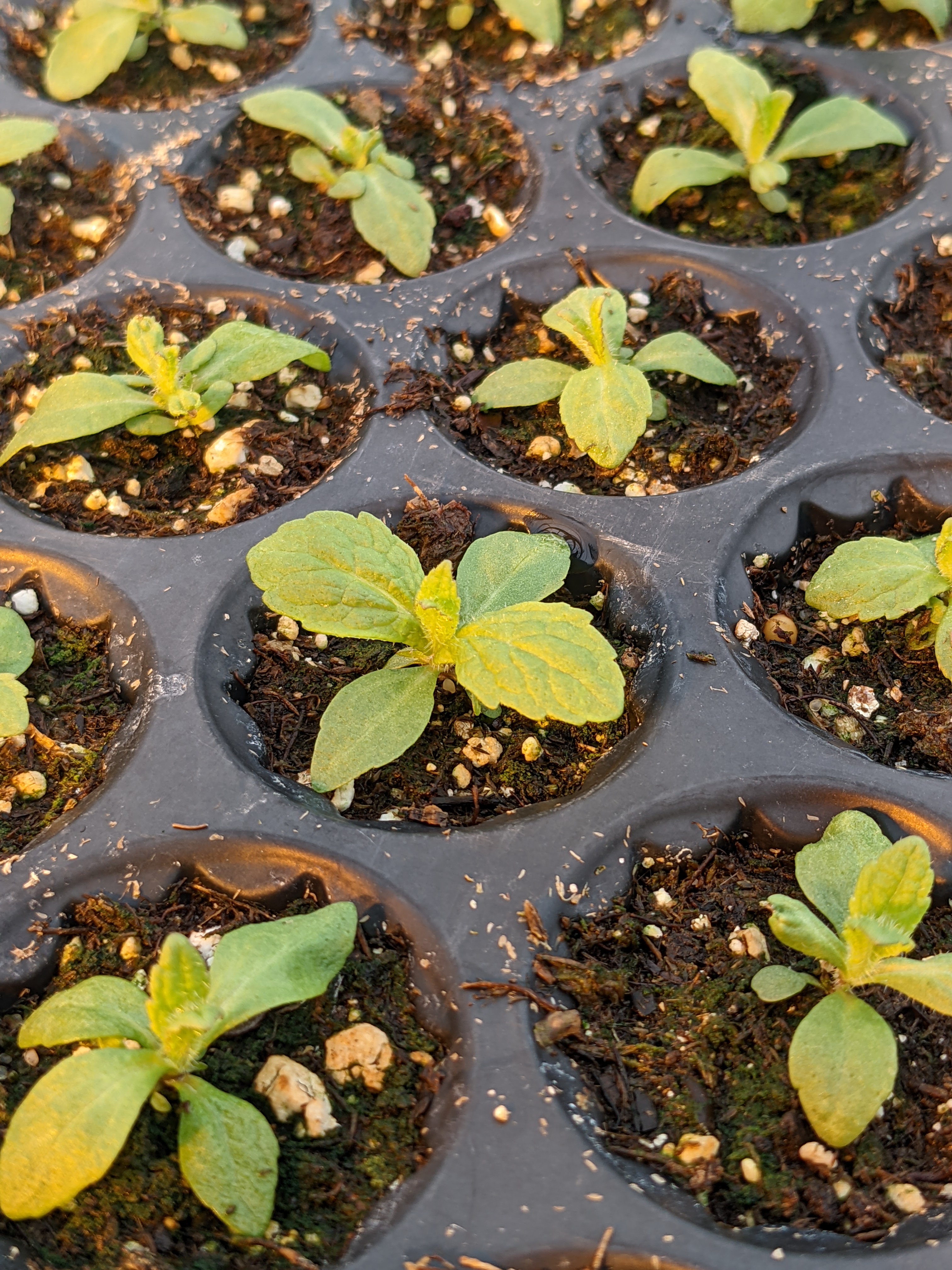
Images (left to right): seedlings of common boneset (Eupatorium perfoliatum) with first true leaves in a germination tray (with wooden chopstick for scale); one of the seedlings extracted with tweezers to show roots at suitable stage for dibbling into plugs (the chopstick serves to dibble a planting hole in each plug); seedlings in plugs two weeks after dibbling.
In the past, the TPC used Stuewe “cone-tainers” for greenhouse propagation. Cone-tainers are designed for accommodating taproot growth in conifer tree seedlings. They worked well for perennial prairie species – particularly those that put down tap roots like compassplant (Silphium laciniatum), butterfly milkweed (Asclepias tuberosa), and Baptisia spp. Various sizes of cone-tainers are available in yellow UV-stabilized plastic for longer life. The so-called “fir” cells, approximately 6.5 in deep with a 1-in. diameter at the top, work well for most native species. Each tray accommodates 200 cone-tainers, 100 cone-tainers per square foot, so it’s also an efficient use of limited bench space. Planting “dibbles” are available that match the size and shape of the cone-tainers. The cone-tainers and dibble system allow the roots of seedlings to be planted deeply enough so that roots can tap into subsoil moisture. Irrigation isn’t necessary, especially with spring or fall transplanting when rains are more frequent.
There is no single “best” container for prairie plant propagation. Some species that form fleshy basal rosettes in the first year of growth (e.g., Lobelia spp.) seem to benefit from being started in wider, shallower plugs or pots. For species that are sensitive to root disturbance during transplanting, consider producing plugs in biodegradable containers such as coir pellets or Stuewe Zipset Plant Bands, made from milk carton paperboard.

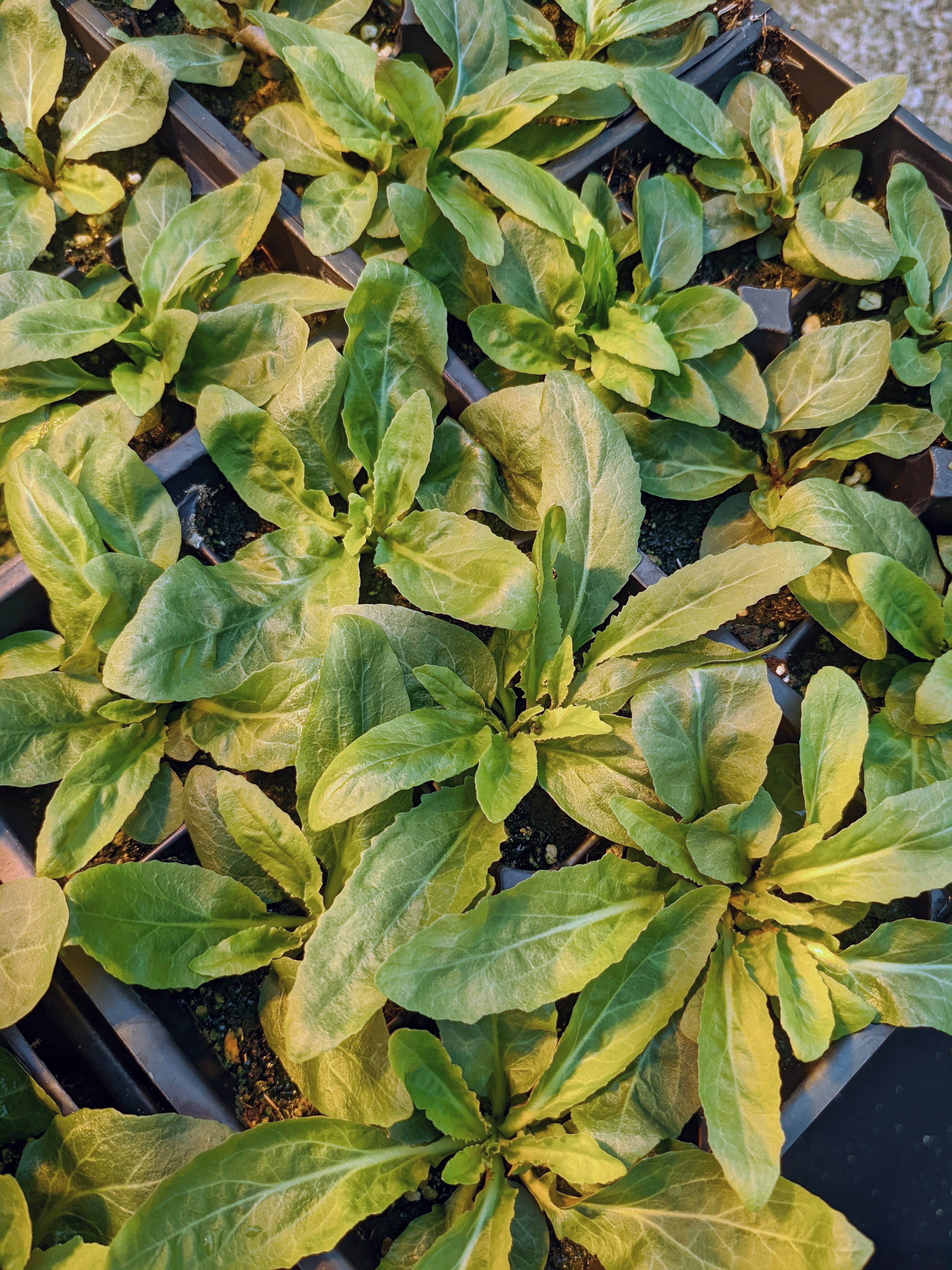
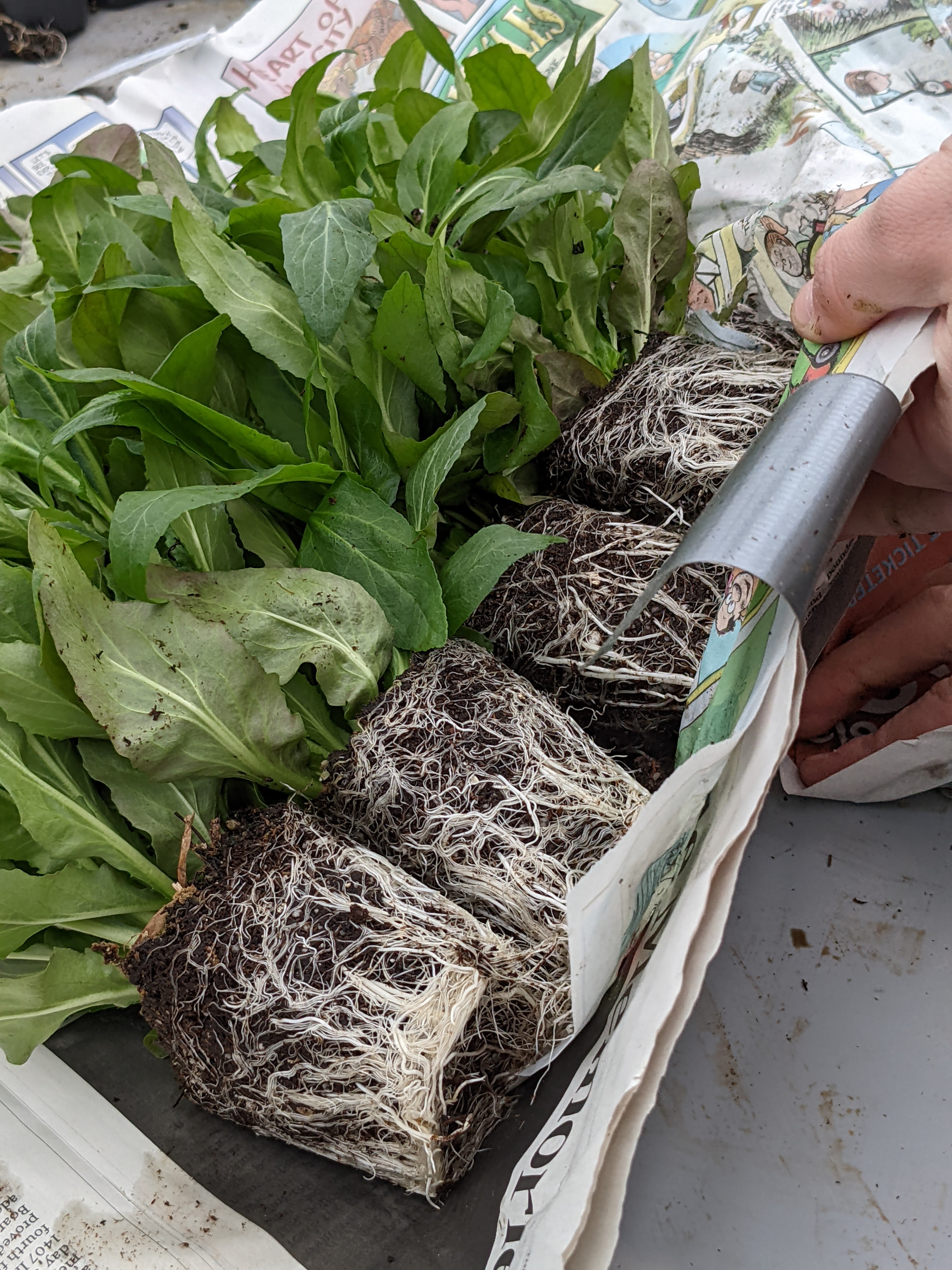
Images (left to right): cardinalflower seedlings (Lobelia cardinalis) nearly one month after dibbling from a germination flat into 6-pack trays; the same seedlings with leafy basal rosettes three weeks later; and plants ready for transplanting to the field six weeks after dibbling into 6-packs.
Potting Medium
A good potting medium should be light enough to allow for good root development, provide adequate drainage, and have enough fertility for seedlings to grow quickly in the greenhouse environment and become large enough for transplanting in a reasonable amount of time. It should also be sterile, meaning free of weed seed and disease organisms. We recommend a soilless mix (less than 20% soil) consisting of 10% sterile soil and 10% composted manure, about 50% milled peat moss or coco coir, and the remainder equal parts perlite and vermiculite.
Caution: All of these materials are extremely dusty. Wear a high-quality particulate mask when handling and mixing materials. Gloves and dust goggles are also recommended. Materials should be moistened before mixing to reduce dust.
Pre-mixed sterile potting mix for plug production can be purchased in bulk from nursery and greenhouse supply companies. Some formulations include potentially beneficial additives such as mycorrhizal inoculum (generally a single species) and biological fungicide (a bacterial species). For propagation of most prairie plants, we supplement “general purpose” mixes by adding additional perlite (2.8 gallons), vermiculite (2.8 gallons), and coated, slow-release fertilizer pellets (19 oz, 15-9-12 formulation) per 3.8 cubic foot compressed bale (7 cu ft expanded). Seedlings are susceptible to damage from over-fertilization, particularly legumes. Controlled-release fertilizer has the added benefit of continuing to provide fertility after transplantation of seedlings into production plots. A drill attachment designed for mixing drywall joint compound helps combine these ingredients while also breaking up chunks of compressed media.
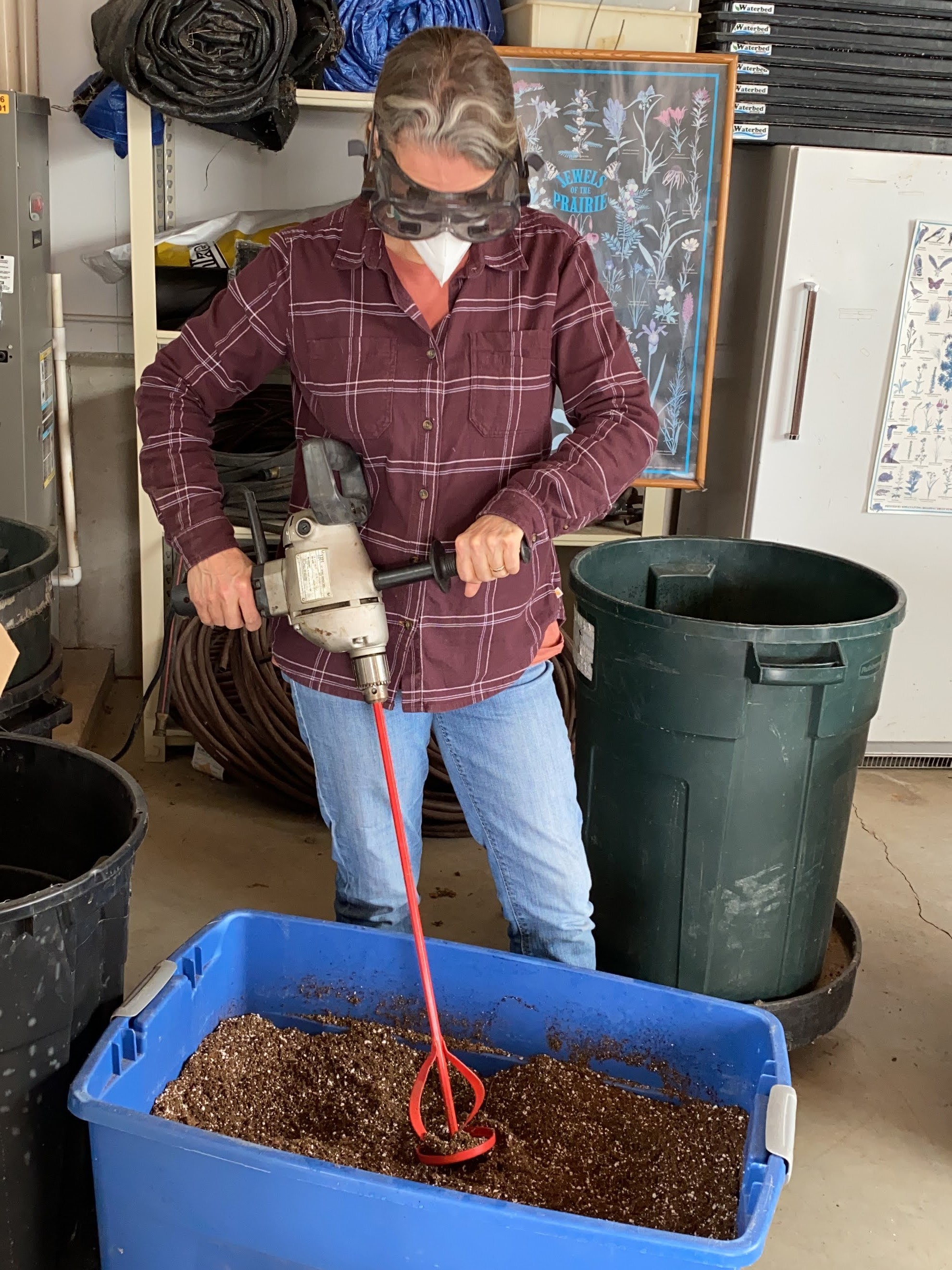
Image: Small amounts of prepared soilless mixes can be amended and mixed efficiently with a joint compound mixer. Goggles and a particulate mask provide protection from dust particles. If you prefer to mix your own potting medium, the recipe below makes approximately 1 cubic yard of soilless mix (enough for 40 trays of 200-cell “fir” cone-tainers). To improve the sustainability of this mix, you could substitute coco coir for the peat moss. Coir is available in compressed, dry bricks that expand greatly when moistened (one 11-lb brick expands to 3 cu ft). If mixing on the floor, sweep and vacuum the area before mixing to remove seeds, debris, and other contaminants:
Peat moss (4 cu. ft/bag) or coir (see above text) 2 bags (8 cu. ft) Vermiculite (medium texture, 4 cu. ft/bag) 1/2 bag (2 cu. ft) Perlite (4 cu. ft/bag) 1/2 bag (2 cu. ft) Sterile soil two 5-gal buckets Composted (sterile) manure manure 40-lb bag Osmocote® Plus fertilizer 15-9-12 (180 days) 8 lb Screen peat moss, soil, and composted cow manure through a ½-in. mesh hardware cloth screen to break up or remove large pieces that would tend to clog and create air pockets as cone-tainers are being filled. Add remaining ingredients, mix with shovels on a clean floor, and fill trays.
Strategy for Filling and Seeding Cone-tainers or Plug Trays
We fill several plug trays at a time within a larger, heavy duty garden tray, banging the large tray several times to settle the medium and sprinkling the plugs with water after each addition of soilless mix, until the level of the medium is consistent across the plugs and flush with the top of the plug tray. It will continue to settle somewhat as the trays are watered in, leaving a little space at the top for water to puddle.
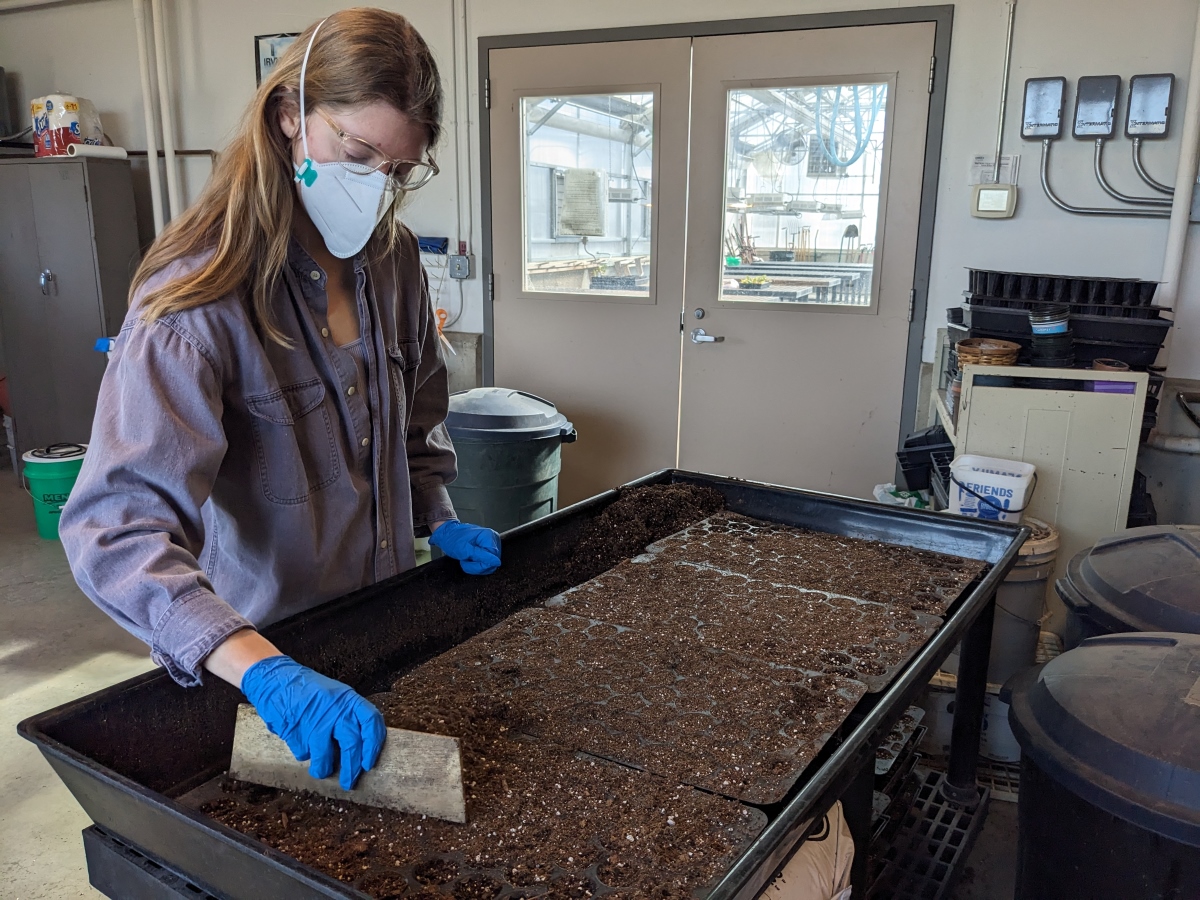
Filling plug flats with potting mix. When filling trays of cone-tainers, tamp the tray on the floor to firm potting medium and remove large air pockets. Avoid overfilling. Leave about ¾-in. unfilled space at the top of each cone-tainer. This space acts as a reservoir during watering, allowing the water to seep in slowly, helping to saturate the entire soil column. Water cone-tainers frequently for a day or two before planting to fully hydrate the potting medium. Refill any cone-tainers that may have settled excessively.
Attempt to sow several seeds per cone-tainer or plug cell. If seed has been mixed with damp sand or other medium for stratification, it may be impossible to distinguish small seeds from the medium. If this is the case, place the damp seed/medium mixture into a shallow dish and mix thoroughly to evenly distribute the seed within the medium. Use a small, flat implement (point of a knife or wood popsicle stick) to place a small amount of mixture in each cone-tainer.
Getting an appropriate number of seeds per cell is guesswork with tiny seeds, but experience will improve efficiency. Thinning may be necessary if too many seeds germinate in each cell, and this could lead to unintended selection. Blank cells will result if no viable seeds were planted, wasting greenhouse space and making it more difficult to achieve even watering. For larger seeds with high purity and viability (90% or more), one to three seeds per container is adequate. Increase accordingly for seed of poor or unknown quality. Cover with no more than 1/8- to ¼-in. of soil for most species. Caution: Very tiny seeds should not be covered! Additional information and precautions on sowing seed of specific species can be found under the following sections on light, temperature, and water requirements for propagation.
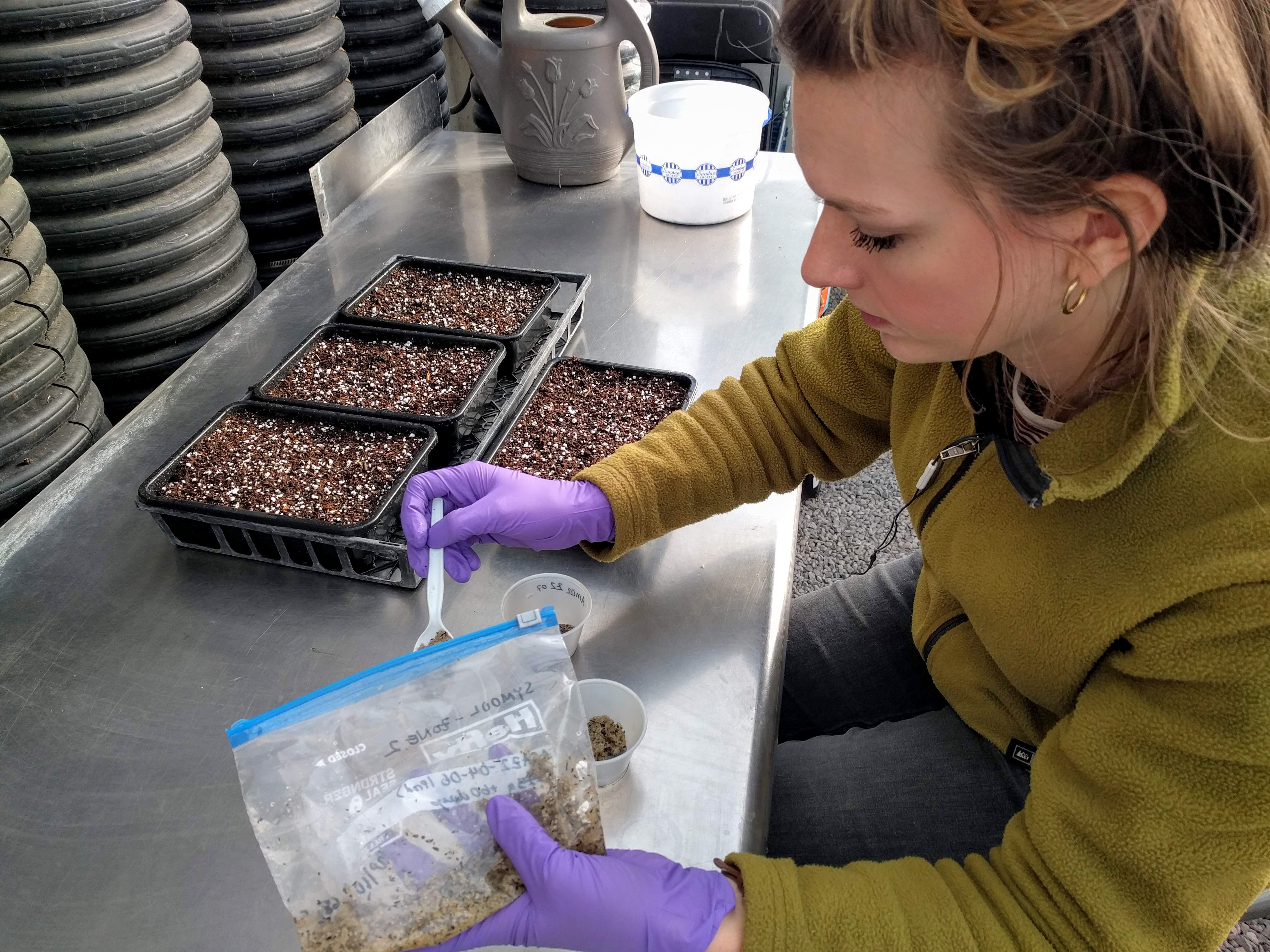
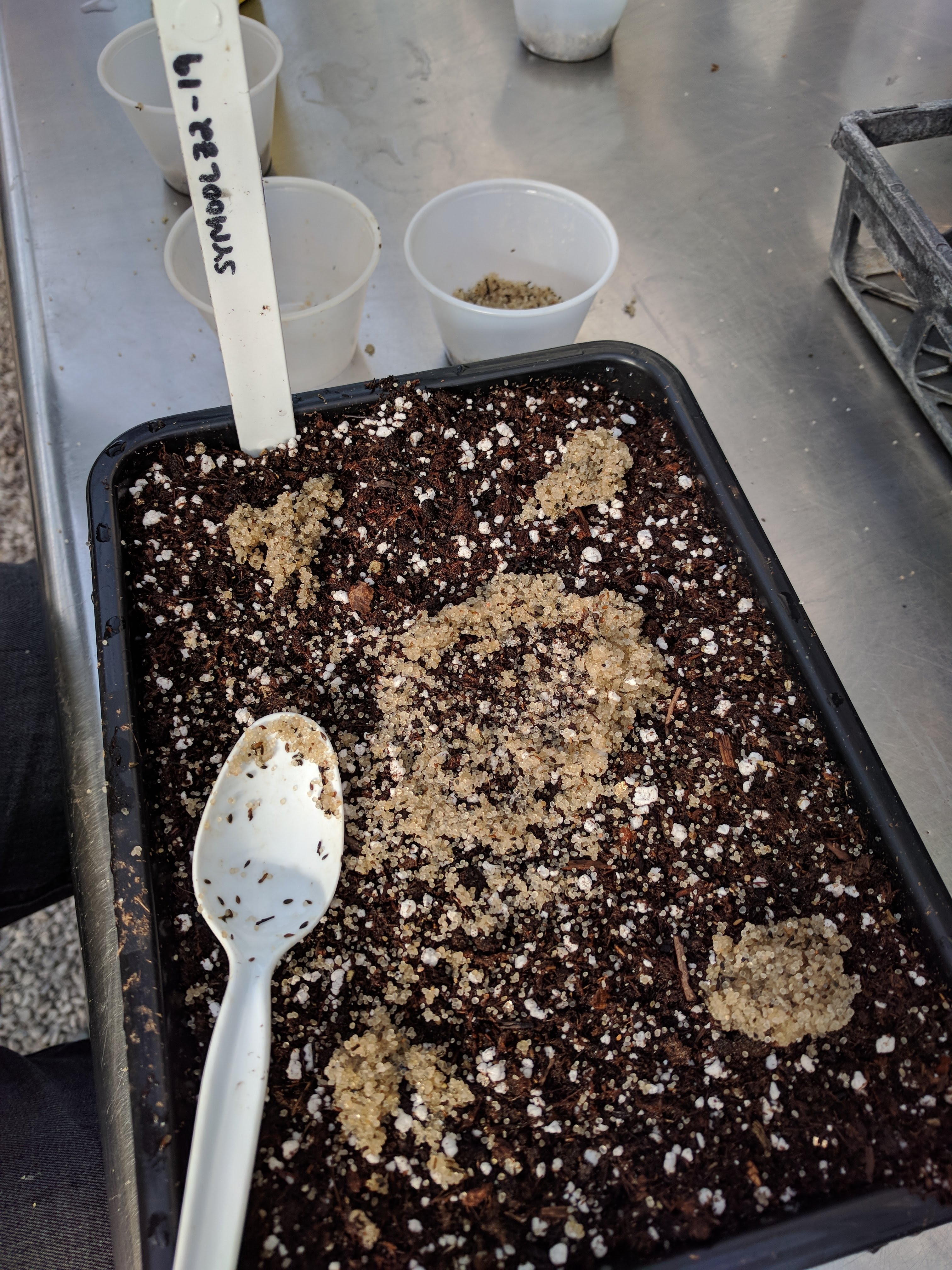
Image: Samples of stratified seed are spread evenly on the surface of prepared germination trays. Small seeds such as these skyblue aster achenes (Symphyotrichum oolentangiense) are very lightly covered with soil.
One strategy to ensure even planting of plug trays is to start seed in germination flats, then prick out seedlings with forceps (tweezers) and transplant them individually into plugs when ready, generally when the first set of true leaves has emerged. There is a risk that individuals with genetic traits that cause them to germinate later could be selected out of the population by this practice. To avoid selection against later germination, retain the germination flats and add later emerging seedlings to plugs when they are ready.
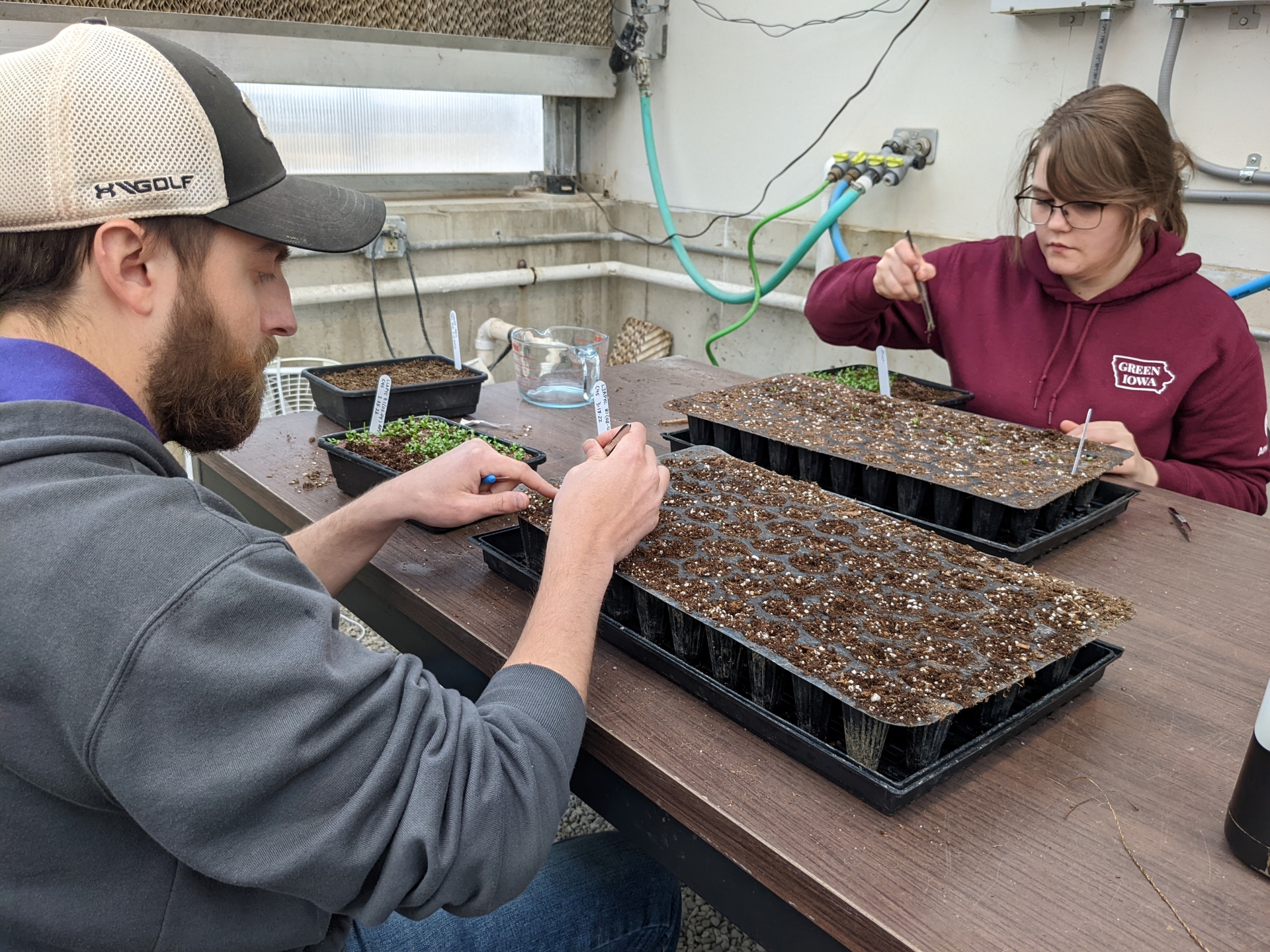
Image: Seedlings from germination trays are dibbled into plugs using forceps, ensuring that all plugs in a flat are filled. This practice is labor-intensive but makes efficient use of seed and greenhouse space. Light
See Appendix A, Table 2A for recommended planting depth and light requirements
Natural light should be sufficient for seedling establishment in the greenhouse from mid-March through mid-September. Sow seeds in early February and expect germination and emergence to occur over a two- to six-week period. Greenhouse-grown seedlings grow well with only natural light through March and April and into May, when transplanting into production plots begins. Some species require light for germination. These are typically small-seeded species, including Culver’s root (Veronicastrum virginicum), mountainmints (Pycnanthemum spp.), grass-leaved goldenrod (Euthamia graminifolia), bonesets and Joe Pye weeds (Eupatorium and Eutrochium spp.), great blue lobelia (Lobelia siphilitica), and prairie sage (Artemisia ludoviciana). These do best if sprinkled on top of the soil surface and kept continually moist until the seed leaves (cotyledons) are evident.
Temperature
Germination will occur throughout a range of temperatures but will be slower with less than optimal temperatures. The risk of fungal pathogens and rot increases if seed does not germinate and is non-dormant. Warm-season grasses and legumes germinate best in warm soils greater than 70°F (21°C ). Cool-season grasses and many forb species will germinate more readily in cool soil temperatures of 40 to 50°F (5 to 10°C) and may cease germination at temperatures above 77°F (25°C). Soil temperature in the planting trays fluctuates with greenhouse air temperature (72°F, 22.2°C daytime and 60°F, 15.5°C nighttime). Pulses of emergence occur on sunny days with some species, presumably because an optimum soil temperature has been reached from solar heating. Covering plug trays or cone-tainers with translucent plastic increases soil temperature and improves the germination of species that require warm soil temperatures. Use this technique with caution. Lethal temperatures can occur quickly under the plastic with full summer sun. Plastic should be removed as soon as the first seedlings emerge to avoid overheating new seedlings. Cooler soil temperatures can be achieved by setting trays on the floor. If sowing seed in germination flats, precise regulation of soil temperature can be achieved with propagation mats. Propagation mats are placed under the flats and are plugged into an electrical temperature control box. Soil temperature in the flats is regulated by a soil temperature probe from the control box inserted into the potting soil of one of the flats. These are commercially available at reasonable cost from nursery or greenhouse supply companies.
Watering
Proper watering is critical to greenhouse propagation. Watering methods must be adjusted depending on the growth stage of the plants. It is important to keep the soil surface moist until germination has occurred, especially for small seeds that require light and are sown directly on the soil surface. An automated mist system is helpful during this stage of propagation. If using a wand or watering can, use a sprinkler head that produces small gentle droplets and low pressure so that watering doesn’t dislodge seed, force it deeper into the soil, or splatter it out of the containers.
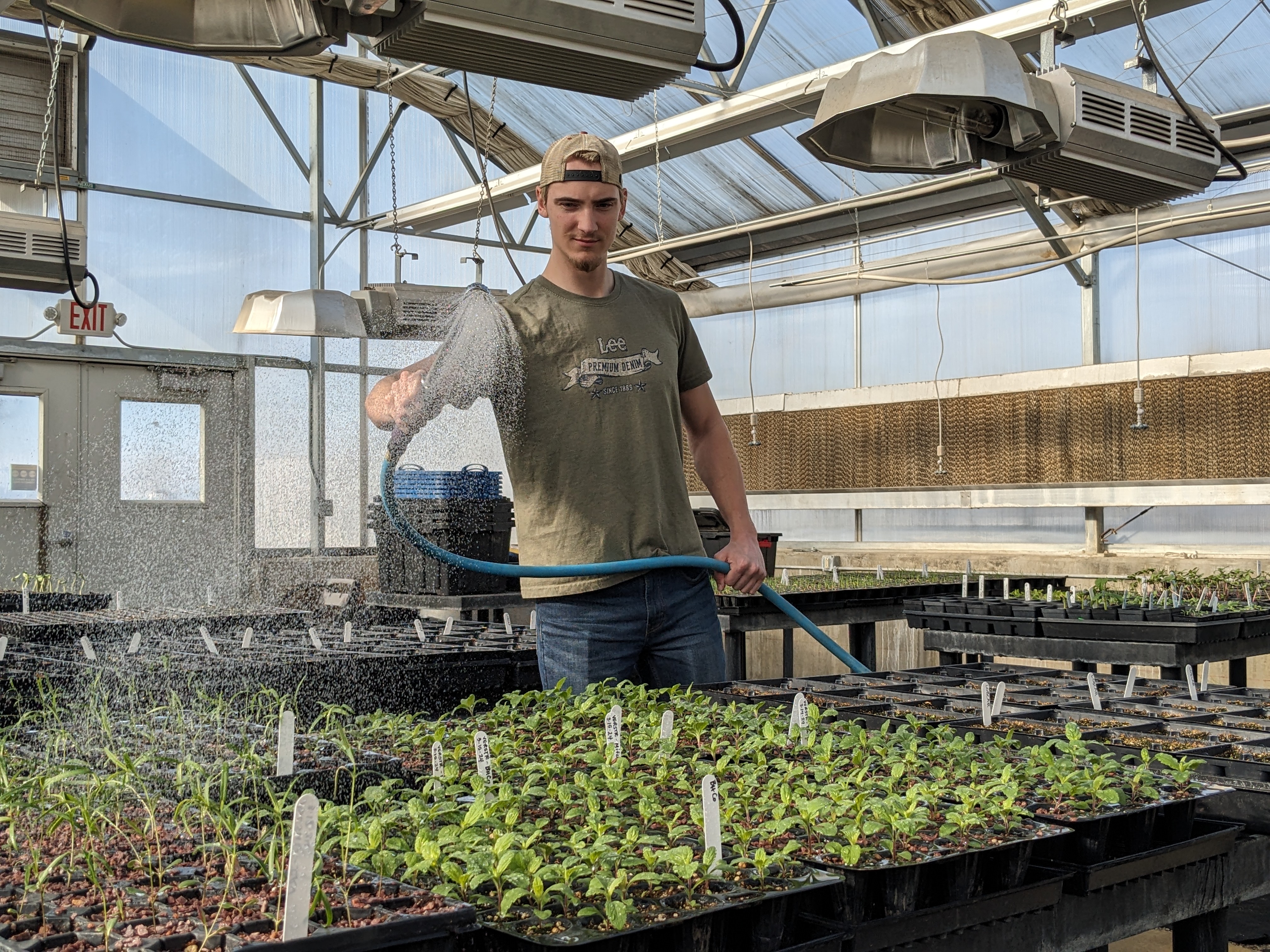
Image: A gentle shower from a watering wand soaks young seedlings without flooding or dislodging them. Established plants should be watered thoroughly about once a day, until water drains from the plugs, ensuring that the entire soil column is moistened. Allow the soil to drain and the surface soil to begin to dry slightly between waterings. Shallow, light watering will cause the lower portion of the soil to dry out and root growth to stall. Containers that are overfilled with soil are prone to underwatering since the water can’t pool on the surface and gradually soak in. Overwatering saturates the soil, depriving the root zone of air and creating conditions conducive to decay. Containers and potting medium that allow for proper drainage will help prevent over-watering. Cool, cloudy days reduce watering needs. More frequent watering (two to three times daily) is required on hot, sunny days and for larger plants with fibrous roots that fully occupy the container.
Excessive watering can also damage shoots. Healthy-looking plants will suddenly fall over, appearing to be cut off at the soil level. This is known as “damping off” and is caused by a fungus. Legumes are particularly susceptible to this condition, but it can affect other species as well, especially if they are planted too densely. Sprinkling a layer of fine chick grit (found in the feed section of farm supply stores) over the top of the soil surface after seeding or transplanting will help dry the soil surface and wick water away from the stems. Maintaining good air circulation will evaporate excess water from stems and the soil surface and minimize the risk of damping off. Place additional fans near benches with species known to be susceptible. Thinning may be necessary to improve air circulation. Watering pots/containers from below by setting them in a pan of water until the soil wicks up moisture may also help. Washing and sterilizing containers, benches, and equipment and using sterile potting media also help reduce the risk of damping off.
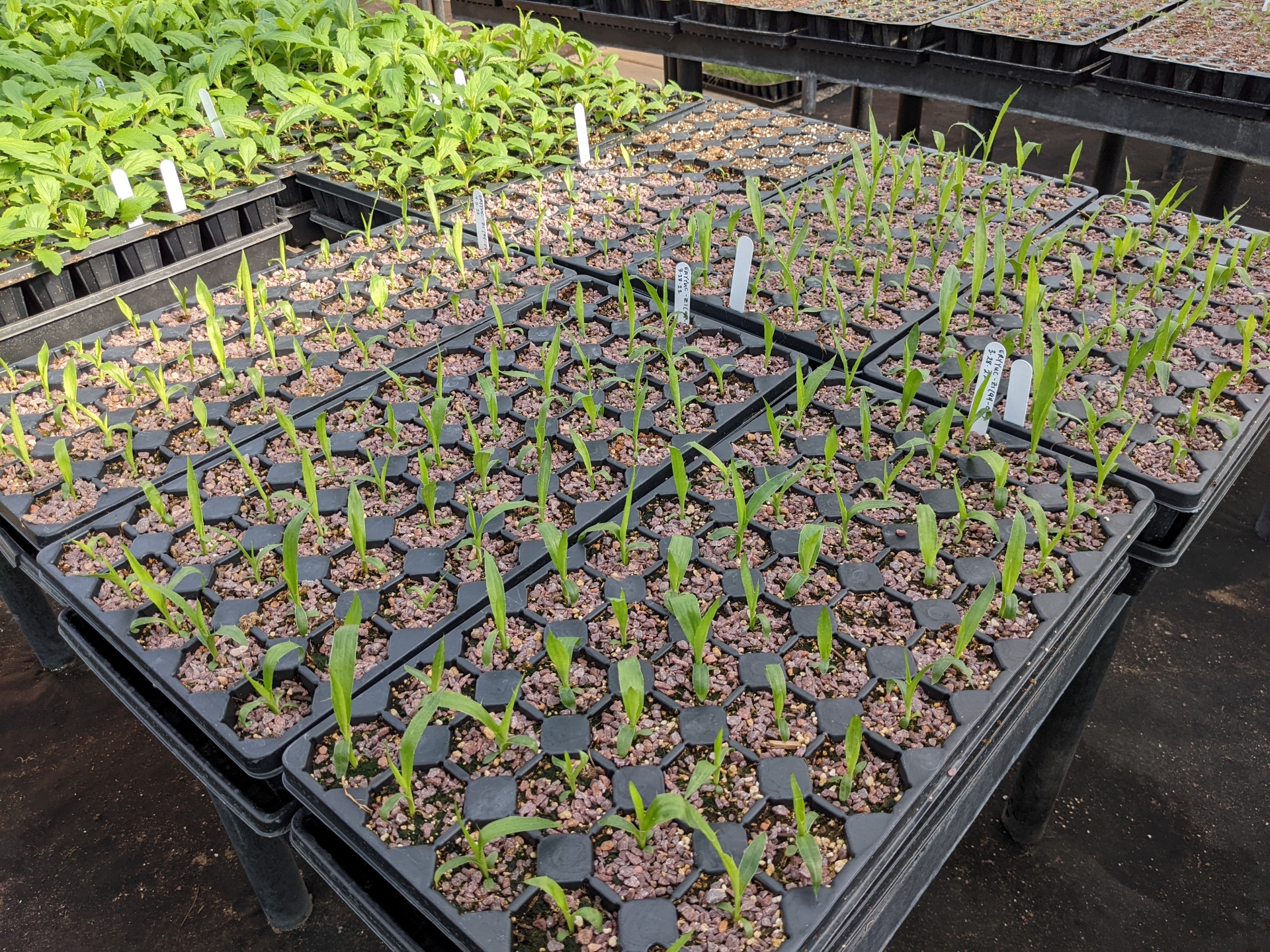
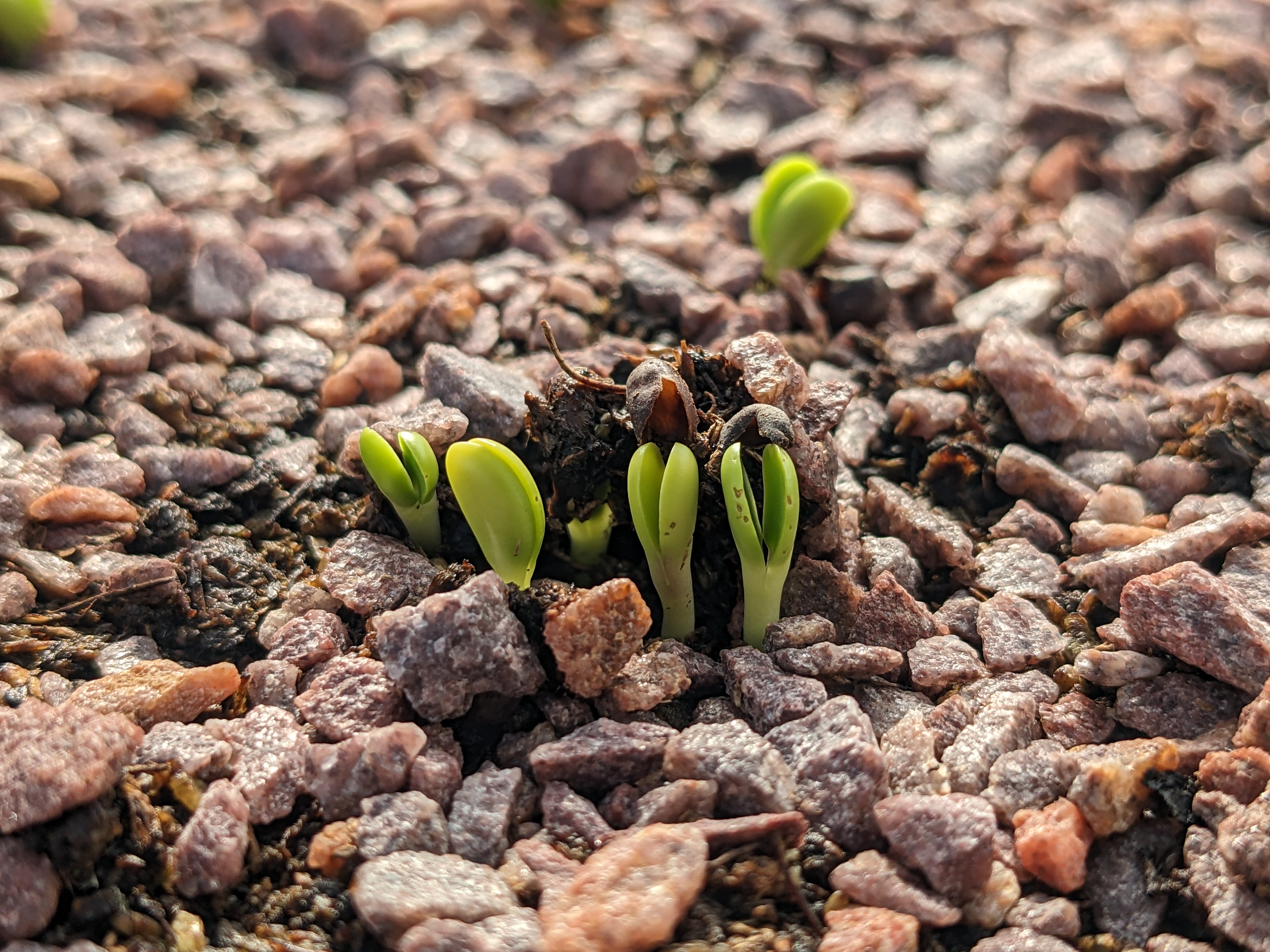
Image: A topping of chick grit keeps the surface around seedlings dry, helping to prevent outbreaks of damping off fungi.
- Transplanting Seedlings
Seedling Development/Timing
The key to successful transplanting of native perennial species is strong root development. Ideally roots should fully occupy the entire soil column so that when the plant is removed from the container, the soil and roots remain intact as a “plug” (i.e., they retain the shape of the container). Grasses and forbs with fibrous roots form beautiful plugs after a few weeks of growth and present little challenge in transplanting. Species with taproots (e.g., Baptisia spp., compassplant, Desmodium spp., butterfly milkweed) develop a thickened fleshy taproot within a few weeks after germination in a greenhouse, but the taproot itself may not be enough to hold the plug intact when transplanting. However, if growth is allowed to continue until the taproot reaches the opening at the bottom of the container, the taproot will air-prune, and fine lateral root growth will be stimulated. These fine lateral roots will help considerably in holding the plug intact when the seedling is removed from the container for transplanting. Slower growing forbs and shrubs require more time for roots to develop adequately for transplant. This process is accelerated by using the 2.5” deep plug trays with ridges and large bottom openings, as opposed to cone-tainers.
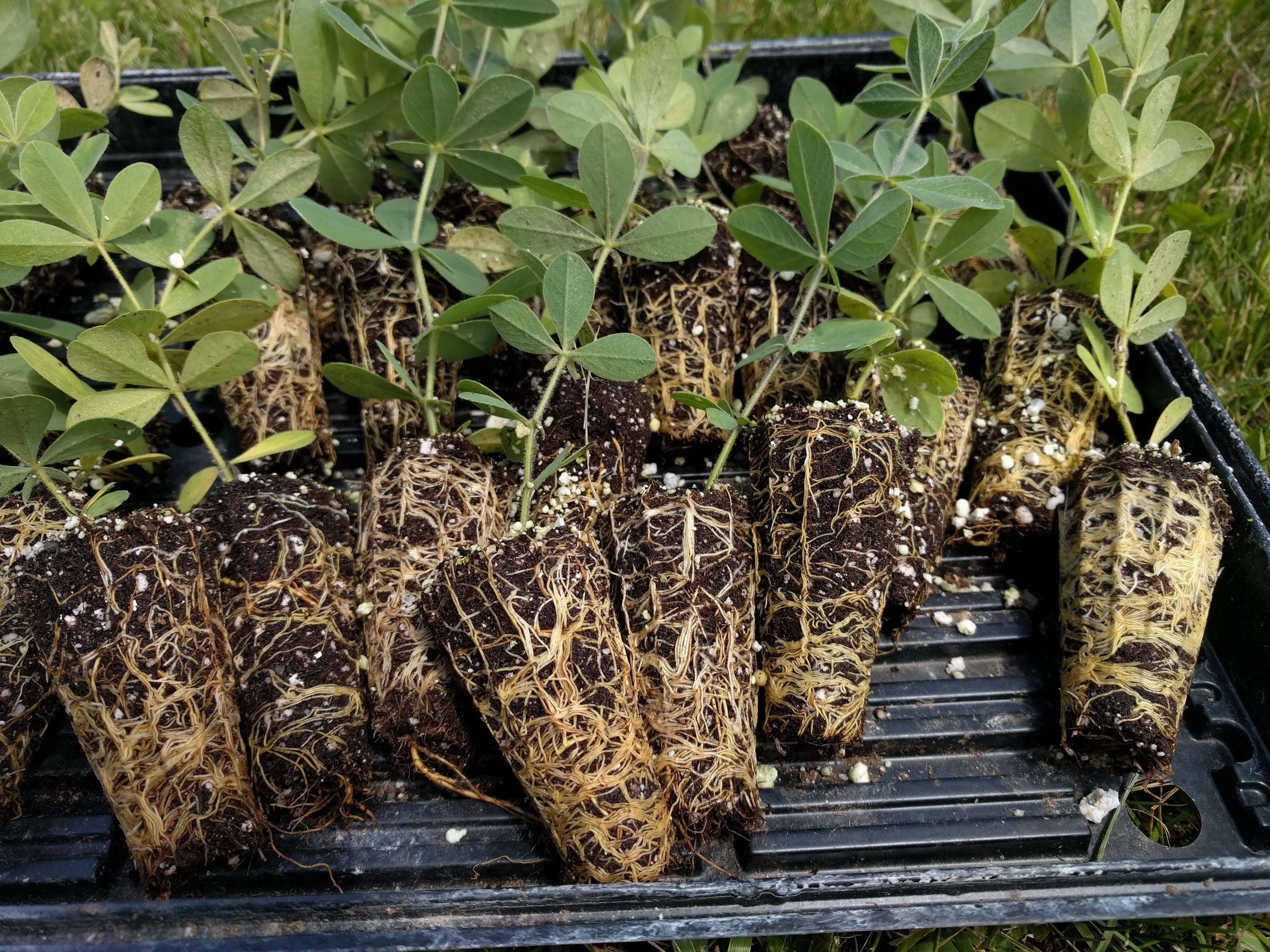
Image: Plugs of a taprooted species, longbract wild indigo (Baptisia bracteata, cream wild indigo). Firmly rooted plugs were produced by growing seedlings in air-pruning containers with grooves and large bottom openings. Seedlings are prone to top-kill when transplanted directly from the greenhouse into the field. Greenhouse-grown seedlings are pampered: they have been protected from drying wind, harsh sun, and herbivores. Robust greenhouse-grown seedlings of many native species can tolerate the stress and will regrow quickly if they have strong root development and adequate soil moisture. A better approach, however, is to acclimate seedlings gradually to outdoor conditions with a process called “hardening off.” A week or two before transplanting, set flats or trays outside for a few hours each day from mid-morning to mid-afternoon in a place sheltered from strong winds and full sun. The idea is to acclimate the plants gradually to outdoor conditions of wind and sun. Strong winds and heavy rains should be avoided. Another option is to move flats/trays into a cold frame (unheated greenhouse) and roll up the sides or open the side vents to allow natural airflow and some direct sun to the plants.
The ideal time for transplanting is in the spring just after the last frost-free date for your region. Rains are more reliable at this time of year, the sun less intense, and plants have the entire growing season to establish and flourish. If transplanting during the summer months, check for adequate soil moisture. Be prepared to water regularly and deeply until plants are established. Transplanting in the fall (early to mid-September) may be another option. Plants transplanted after mid-September may not have enough subsequent root growth to anchor them in the soil, making them vulnerable to frost-heaving.
Bare Soil vs. Weed Barrier
To establish seed production plots, seedlings can be transplanted into weed-free bare soil or a weed barrier. Transplanting into killed sod works well for natural landscaping with a mixed assemblage of prairie species but is not recommended for seed production plots. The dead sod interferes with cultivation and hoeing should weeds become a problem.
Aggressive clonal species like wild bergamot (Monarda fistulosa), prairie coreopsis (Coreopsis palmata), Culver’s root (Veronicastrum virginicum), and prairie cordgrass (Spartina pectinata) can be successfully established as seed production plots in bare soil. Good weed suppression, as always, is critical. Pre-emergent herbicide (Pendulum®, Prowl®) can be used on the site after transplanting to inhibit weed seed germination. Be sure to water in seedlings after transplanting to settle soil around the root zone before applying pre-emergent. Otherwise rain may concentrate run-off of herbicide into freshly dibbled holes containing the new transplants, damaging roots or killing the seedlings. Do a small test plot on species not listed as tolerant on the product label. Read, understand, and follow all precautions and directions on the product label. Planting 8 to 12 in. apart in well-spaced rows (32 to 36 in.) will permit cultivation later that season for weed control. Do not cultivate as long as pre-emergent herbicide remains effective in suppressing weed seed germination. These aggressive clonal species will spread and create solid rows in two to three years. Seed production begins to decline after the third year and may drop off sharply after the fourth year as plants become root-bound within the rows. Aerating the soil with a turf-type aerating implement in the fall or early spring may extend plot productivity.
Weed barrier comes in a variety of materials: plastic film, woven fabric, paper, and fiber mats. Plastic film is inexpensive but less durable than most other types of barriers. Plastic creates abnormally moist conditions that can increase disease problems in some species but may be suitable for short-term (one to two-year) applications. Biodegradable plastics are available which begin breaking down after the first growing season. Plastic film can be applied mechanically using an implement that creates a flat or raised bed while simultaneously rolling out and securing the plastic. Irrigation tubing can be laid at the same time for species needing additional moisture. Plugs can be transplanted into holes dibbled through the plastic film. When using 4-ft wide plastic, we typically plant four plugs per row in rows about a foot apart. We adjust this plant spacing to accommodate larger species such as compassplant.
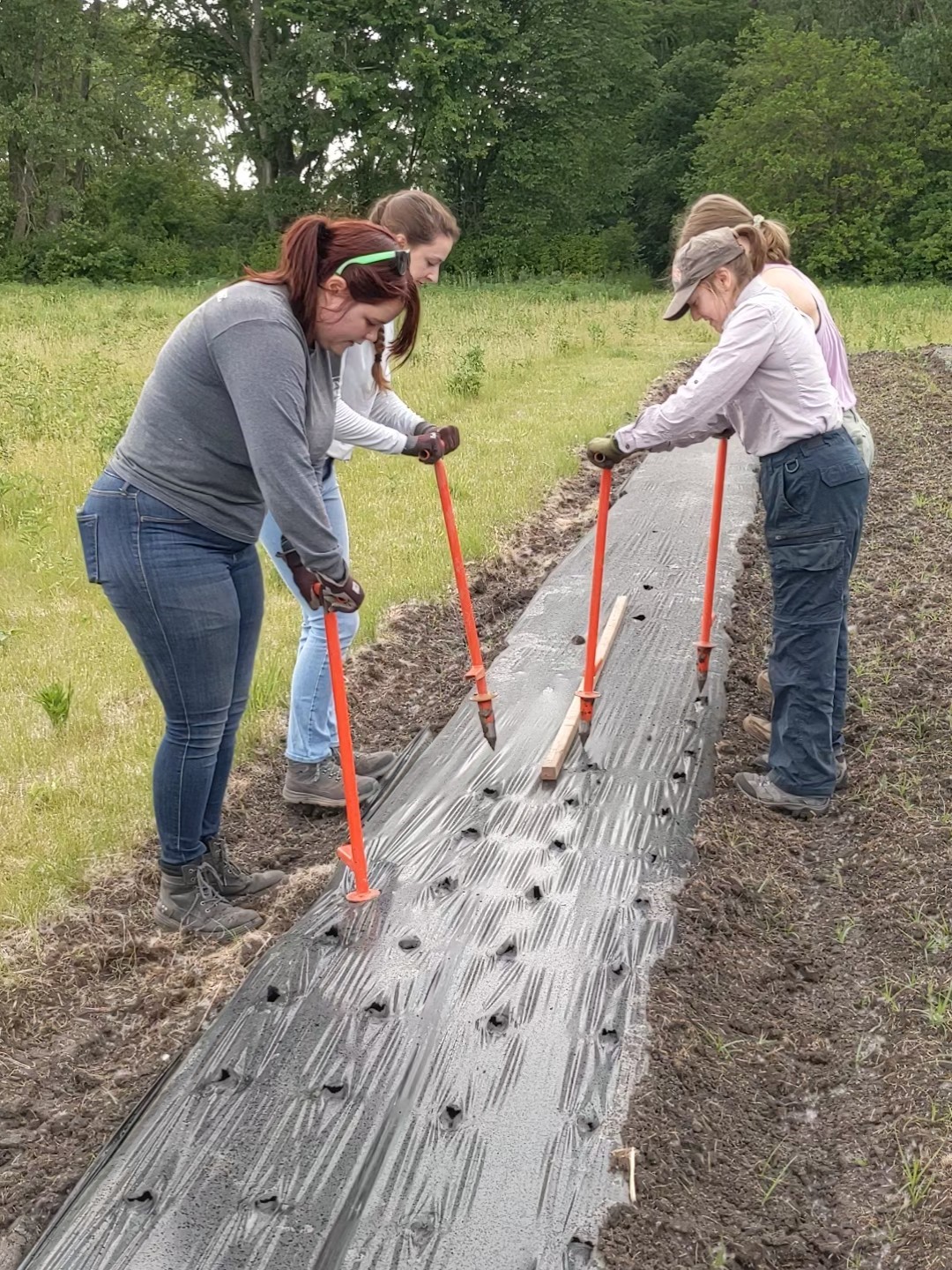
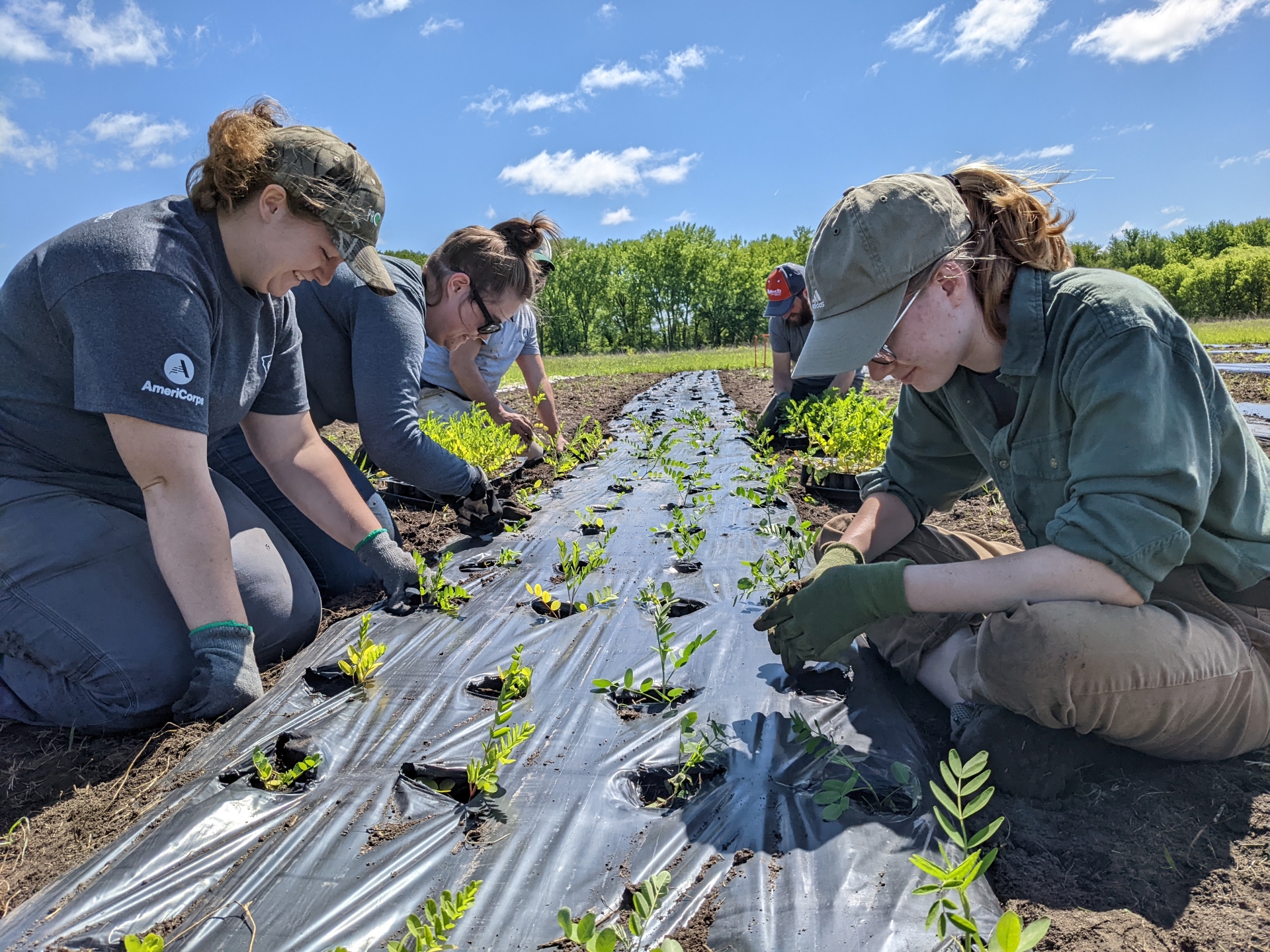
Image: Metal dibbles punch planting holes directly through plastic weed barrier. Most species are planted in rows of four spaced one foot apart.
As the name implies, a weed barrier suppresses weed growth by blocking light, physically obstructing shoot growth, and by solar heat sterilization of weed seeds in the soil. Weed barriers also conserve soil moisture, and plants grow more vigorously with a weed barrier than in bare soil. For these reasons, weed barriers aid establishment in the first year and increase seed production in the second year for most species. By the third year, aggressive clonal species will send rhizomes in all directions that the barrier would smother. For these species, plant in bare soil as described above, or use an inexpensive barrier that biodegrades or can be pulled up after the second season.
In the past, we used a durable, water- and gas-permeable weed barrier (DeWitt Pro woven landscape fabric) for long-term applications (up to ten years). This can be purchased in rolls 6’ x 250’ or 12’ x 300’ rolls. This type of weed barrier provides long-term benefits of weed suppression and moisture retention for less-competitive species that establish slowly. It’s also a good choice for species with taproots that remain where they are planted (non-clonal). However, removal and disposal of fabric weed barriers after many years in the field is very difficult, as perennial grasses and other weeds grow through the degrading barrier, uniting it with the soil.
Transplant seedlings of non-clonal species into weed barrier fabric 8 to 12 in. apart in blocks or rows to optimize the use of this costly product. Slits are cut in the fabric weed barrier using a tool made of modified sickle bar blades mounted on a wooden 2x4 with an attached handle. This device cuts four “x-shaped” 2-in. slits, 8 in. apart at one time. Cutting larger slits would allow more weeds to germinate and come up through the openings. Precise holes can also be burned into weed barrier fabric using a propane-fired hole cutter available from greenhouse and nursery supply companies.
Regardless of the type of barrier used, some hand weeding will be necessary, especially during the first growing season. Hand-pull weeds that emerge through the barrier openings while they are small, taking great care not to disturb new transplants. Pressing gently downward on the top of the newly transplanted plug while pulling adjacent weeds will protect it from being uprooted. A garden or dandelion knife can be used carefully to slice through the taproots of larger weeds. Slice into a taproot just below the soil surface, again taking care not to damage the roots of transplants. Hand weeding periodically throughout the first growing season will be required to give transplants the best chance of establishing the first year and producing a good seed crop in subsequent years.
How to Transplant Seedlings
Soil should be firm in all cases. If dibbling into bare soil, the soil should be rolled or packed to prevent dibbled holes from collapsing. Likewise, very dry soils resist dibbling. It may be necessary to sprinkle the area the day before or wait until a day or two after a soaking rain. Just before transplanting, liberally water seedlings to fully saturate the root plugs. This will make it much easier to remove the plugs from the trays or cone-tainers and provide extra moisture to the root zone after transplanting. To remove plants from a plug tray, use a stick or gloved finger to push up through the opening at the base of each plug. Hold the plant at its base and pull gently. If the plant does not release easily, try “massaging” to loosen the root plug from the sides of the cell. If the plants are in cone-tainers, hold a cone-tainer upside-down firmly in one hand, and rap the rim of the cone-tainer sharply on the palm of the other hand, using a flick of the wrist. The plug should slide out easily; repeat if necessary. (If plugs do not hold their shape upon removal, either the roots are not adequately developed or too much force is being used. Transplant success drops significantly if this happens!) Slide the intact plug into a dibbled hole – it should just fit, with the top of the root plug just at or slightly below the soil level. Pinch soil firmly around the top of the plug to seal in moisture, taking care not to bury the base of the shoot. The lighter soil-less mix can wick moisture away from the roots if left exposed. Be sure dibbled holes are deep enough to comfortably receive the full depth of the plug. Plugs forced into a too-small or shallow hole will often pop out of the ground after a good rain, exposing the root collar.
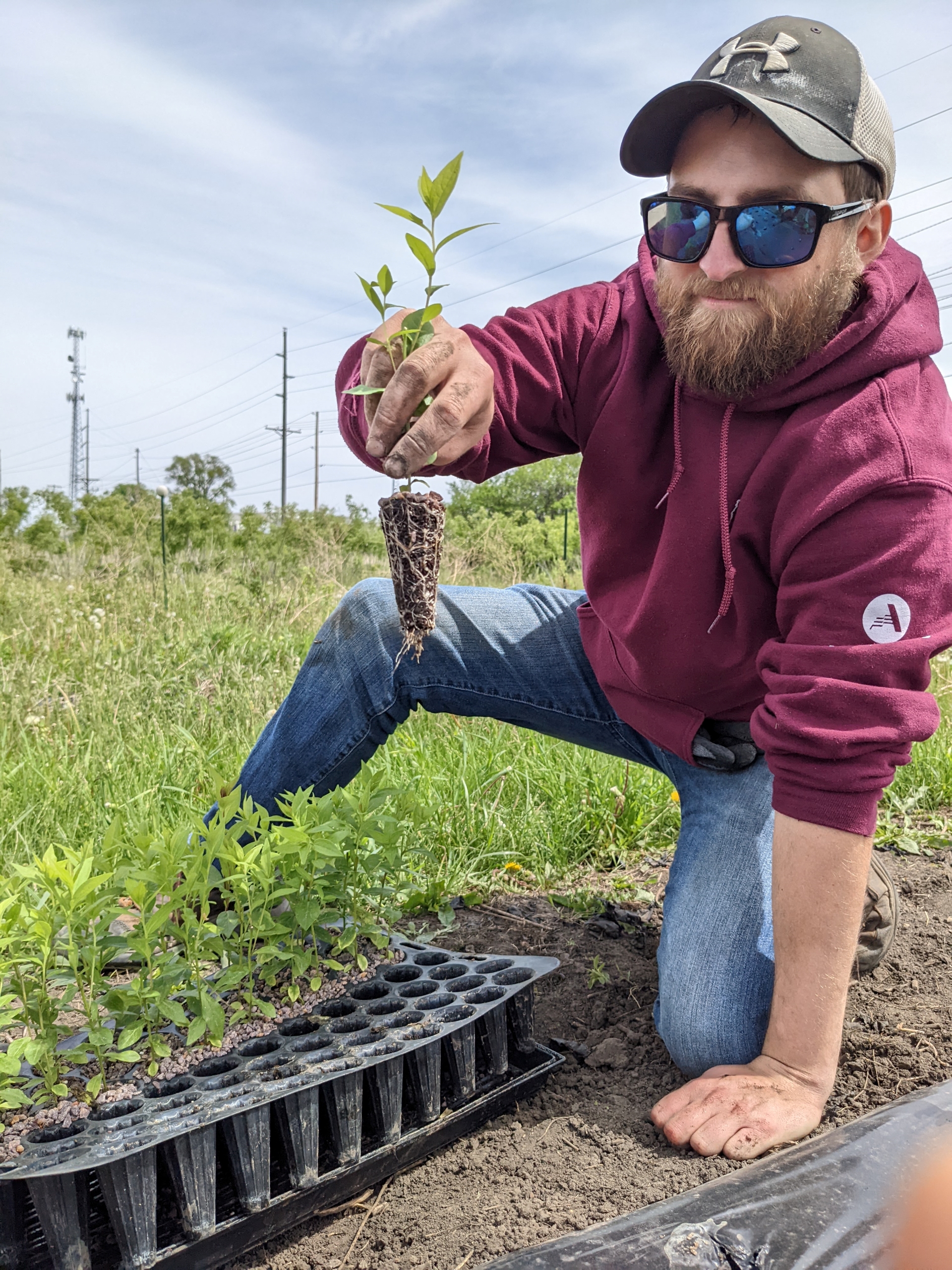
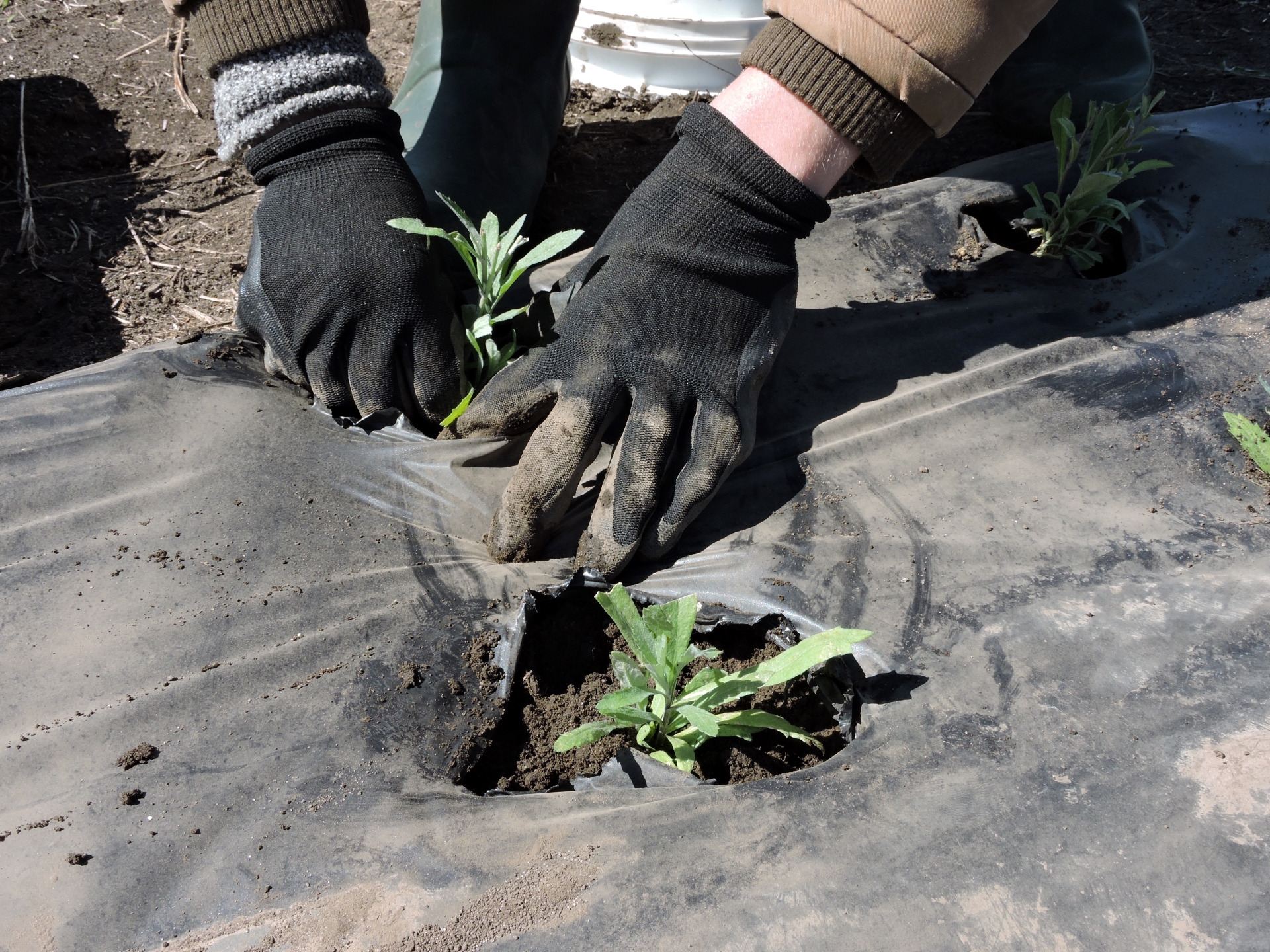
Image (left to right): Well-rooted plugs pop out of trays intact; plugs are "pinched in" to achieve good contact between roots and soil and topped with a thin layer of field soil to prevent moisture from wicking out of the potting mix.
- References
Baskin, C. C., & Baskin, J. M. (2003). When breaking seed dormancy is a problem: Try a move-along experiment. Native Plants Journal, 4(1), 17–21. https://doi.org/10.3368/npj.4.1.17
Baskin, Carol C., & Baskin, J. M. (2014). Seeds: Ecology, biogeography, and evolution of dormancy and germination. Elsevier / Academic Press.
Deno, N. C. (1993). Seed germination: Theory and practice. available for free download from the USDA National Agricultural Library at https://search.nal.usda.gov/permalink/01NAL_INST/27vehl/alma9916347016207426
Khadduri, N. Y., & Harrington, J. T. (2002). Shaken, not stirred - a percussion scarification technique. Native Plants Journal, 3(1), 65–66. https://doi.org/10.3368/npj.3.1.65
Native Plant Network, USDA Forest Service. (n.d.). Propagation protocols database. Reforestation, Nurseries, & Genetic Resources (RNGR). https://npn.rngr.net/propagation/protocols
Society for Ecological Restoration and Royal Botanic Gardens Kew. (n.d.). Seed information database. https://ser-sid.org/about

